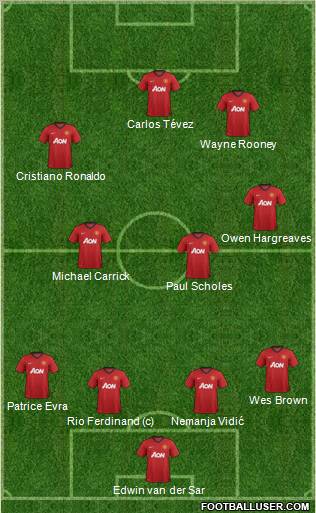
Manchester United Football Formation
Lineup (4-3-3)
Edwin van der Sar · Rio Ferdinand (c) · Nemanja Vidić · Patrice Evra · Wes Brown · Paul Scholes · Michael Carrick · Owen Hargreaves · Cristiano Ronaldo · Wayne Rooney · Carlos TévezManchester United "Fantastic XI" (2006 - 2009)
Unlike most champion sides of the history, Manchester United have not used a specific formation in their amazingly successful three seasons. Sir Alex Ferguson has used a variety of formations – 4-3-3, 4-4-2, 4-5-1, 4-2-3-1, 4-4-1-1 – and probably a few others.
With so many different formations, a rigurous squad rotation system and key players bought and sold during this time, it would be difficult to sum up the side simply by giving a diagram of eleven players, and saying “They played this way for three seasons”.
The side they won the Champions League with in 2007/08 seems the best XI to describe in detail, however. Always featuring a back four with two relatively deep central midfield players, Ferguson generally used an additional midfield player, with a fluid front three of Cristiano Ronaldo, Wayne Rooney and Carlos Tévez.
The reasons Ferguson could afford such a loose shape in the final third were that (a) Ronaldo, Rooney and Tévez were all highly versatile, happy to play either on the wing or through the middle, (b) The three had a wonderful understanding in and around the penalty area, meaning Ferguson could effectively hand out three ‘free roles’ and sit back and witness the results and, crucially (c) All three understood their defensive responsibilities.
Of course, the key feature of the side was, in a move often described as being influenced by Luciano Spalletti’s Roma side, United featured no permanent frontman. Ronaldo was primarily a winger, who developed his game both technically and physically to become both a goal threat from the wing, as well as a powerful presence upfront when needed – whilst Rooney and Tévez were small, creative forwards who liked dropping deep and were both extremely hard-working.
The fluid front three were not always all used, however. In away European games that season, one of them (Tévez) would sometimes be sacrificed for a hard-working midfield player, such as Park Ji-Sung. United’s win that season away at Roma will go down as one of the great away performances in Europe by an English club. Rooney played wide on the left in a fairly flattish midfield five, whilst Ronaldo was given the lone striker role. Whereas Francesco Totti invented the ‘false nine’ role by dropping deep into central midfield areas, Ronaldo played it by both dropping deep and drifting into the wide areas, creating a dilemma for the now-redundant Roma centre-backs. When he dropped deep, one of Park or Rooney would become the highest player up the pitch. United won 0-2, with the first goal a brilliant, towering, ‘classic centre-forward’ header from Ronaldo.
But the versatility of the front three meant Ferguson could easily change his system against different opponents. Whereas Ronaldo played upfront against Roma with Rooney on the left, against Chelsea in the final the positions were reversed, with Ronaldo deployed on the left to terrorize Michael Essien, out-of-position at right-back. Indeed, it was Ronaldo’s aerial dominance over Essien that resulted in United’s goal. Their ability to change individual player roles without compromising the overall shape or understanding of the team is largely what has made them such a success.
There is a perception amongst some journalists that Ferguson is not a great tactician, but the more time that passes, the less this seems true. Away in Europe over the past couple of years, United have been devastating, and the way United set out against Arsenal at the Emirates this season will turn out to be one of the most influential games of the decade in terms of tactics.
Today, Ferguson continues to vary between 4-3-3 (and variants) and a 4-4-2 (and variants). Within the squad, Ferguson seems to have players that are specifically used in one of the two systems. Park Ji-Sung is brilliant in a 4-3-3 as a defensive wide attacker, whilst Anderson is most effective at the head of a fairly defensive three-man midfield. On the other hand, Berbatov doesn’t appear to fit into the 4-3-3 and is solely used in the 4-4-2. Ferguson’s key central midfield players – Darren Fletcher, Paul Scholes, Michael Carrick and (when fit) Owen Hargreaves can all play slightly different roles whether in a midfield three or four.
By no means the first great Manchester United team Sir Alex Ferguson has created, but certainly the one that owes most to tactical innovation.
Coach/Manager : Sir Alex Ferguson
Reserves include : Tomasz Kuszczak, John O'Shea, Mikaël Silvestre, Anderson, Ryan Giggs, Nani and Darren Fletcher.